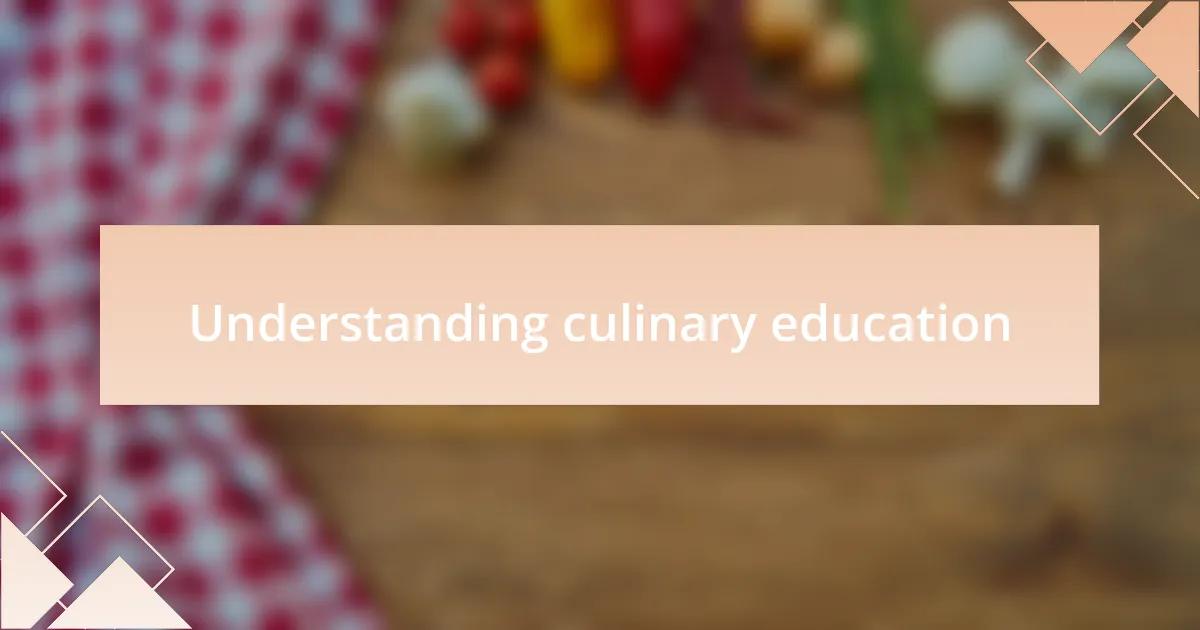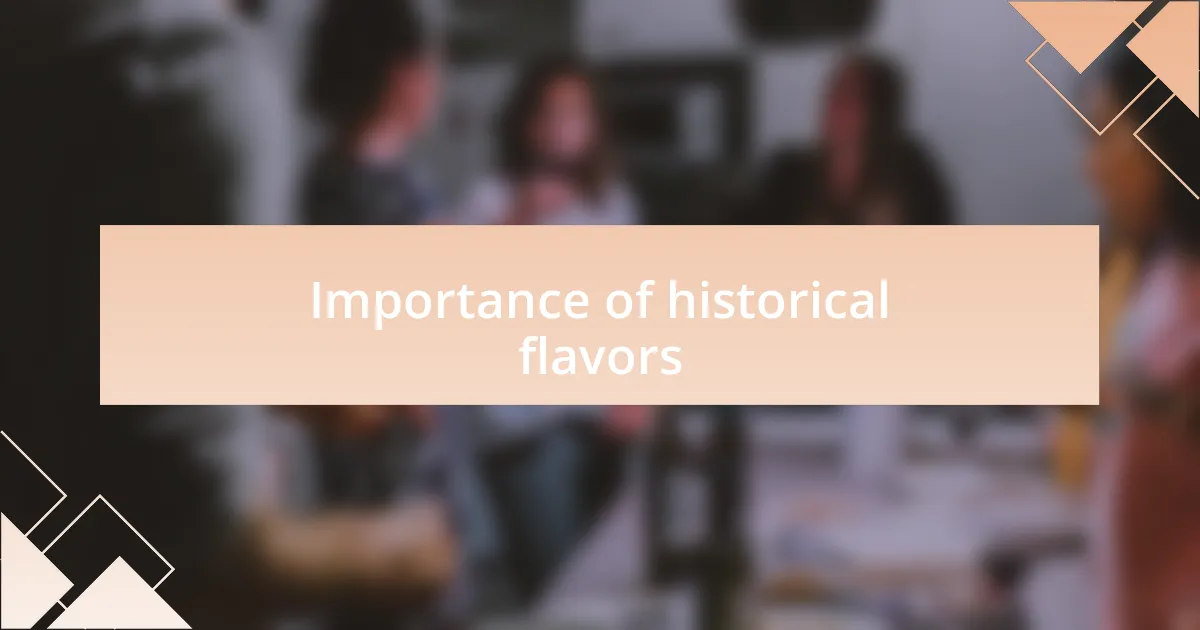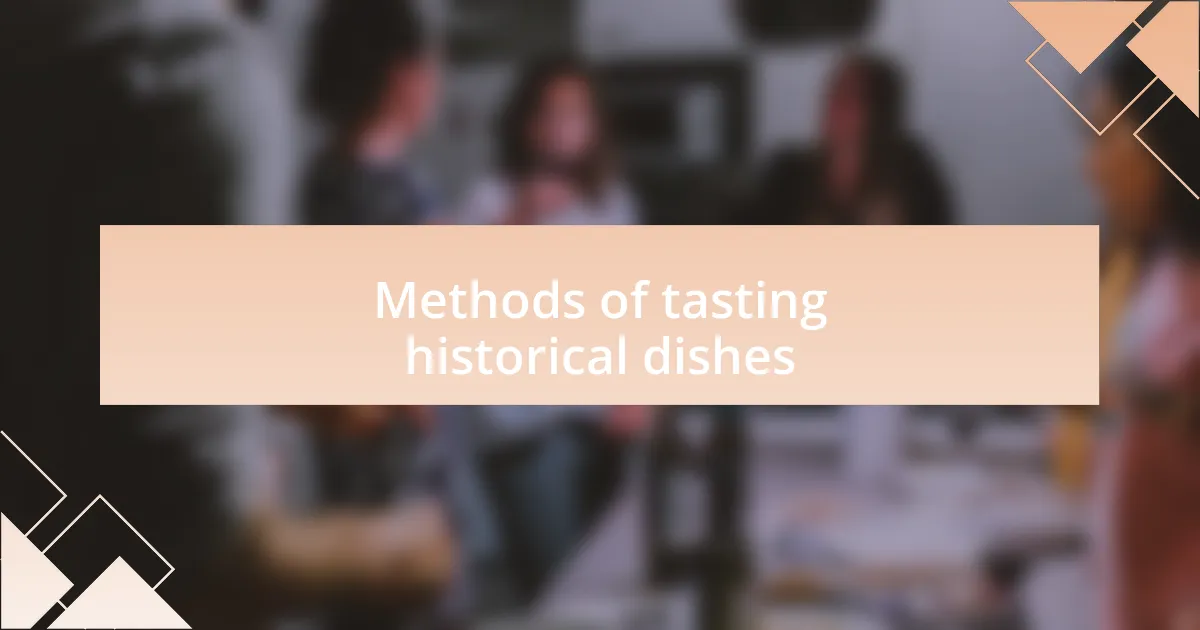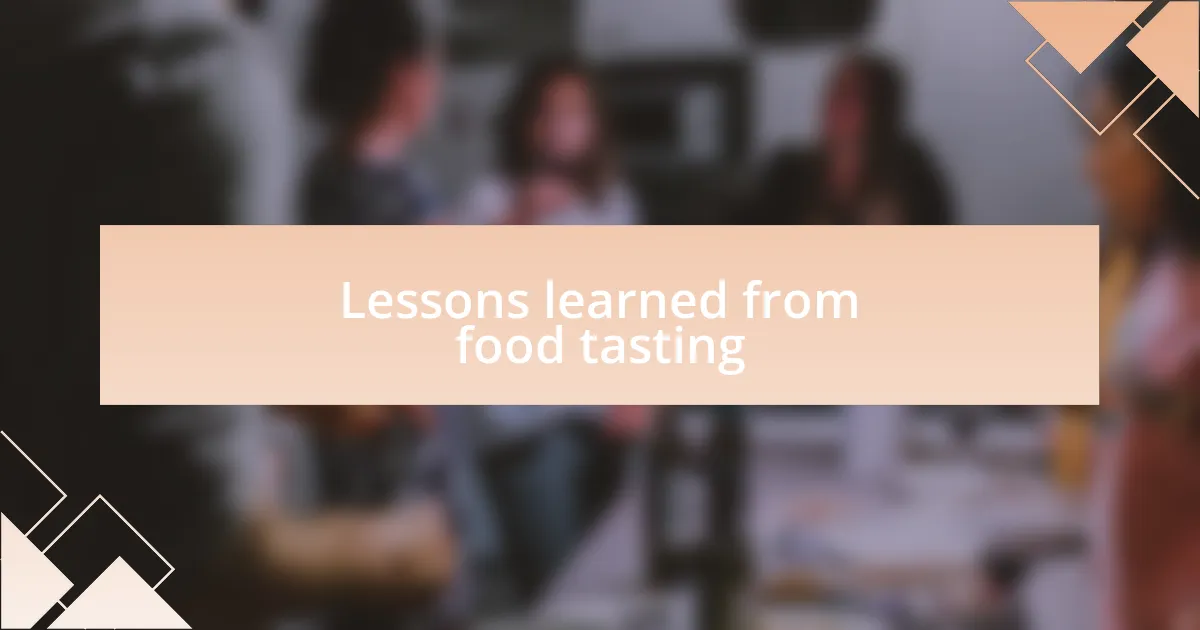Key takeaways:
- Culinary education encompasses not just recipes, but also the cultural, historical, and scientific aspects of cooking.
- Exploring historical flavors reveals insights into socio-economic contexts and culinary practices of different eras.
- Authentic cooking methods and shared food experiences enhance the appreciation of historical dishes.
- Tasting foods from various periods highlights the evolution of culinary techniques and ingredients, fostering a deeper connection to history.

Understanding culinary education
Culinary education is not just about learning recipes; it’s about understanding the culture and history behind each dish. I remember the first time I made a classic French béchamel sauce. As I stirred the flour and butter, I felt connected to generations of cooks who had mastered this fundamental technique. It made me wonder, how many hands have crafted this creamy foundation that elevates so many dishes?
Moreover, culinary education delves deep into the science of cooking. I was fascinated when I learned about the Maillard reaction, that magical moment when proteins and sugars transform into a wonderful brown crust. It reminded me of the countless times I’ve baked bread—each loaf a testament to the chemistry happening beneath the crust. Isn’t it incredible to think that something so simple can be so profound?
Finally, culinary education emphasizes the importance of mindfulness and creativity in cooking. Reflecting on my own journey, I recall a moment when I spontaneously decided to infuse my pasta with local herbs, creating a unique dish that was truly mine. This experience highlighted that cooking can be more than just following instructions—it’s an art form, an expression of who we are in that moment. How often do we allow ourselves the freedom to experiment?

Importance of historical flavors
Historical flavors serve as a bridge to our past, offering insights into the ingredients and techniques that shaped our culinary heritage. I vividly recall savoring a dish inspired by ancient Roman cuisine; the rich combination of herbs and spices transported me back to a time when flavors were as much about preservation as they were about enjoyment. Isn’t it fascinating how the culinary practices of yesteryear still influence our kitchens today?
Exploring these flavors allows us to understand the socio-economic contexts of different eras. I remember tasting a humble peasant dish from medieval Europe that reflected the scarcity of resources yet showcased incredible creativity. It begs the question: how can we channel that same ingenuity in our modern cooking?
Moreover, reconnecting with historical flavors ignites curiosity about the globalization of ingredients over time. I often find myself pondering how the spices that once traveled the Silk Road continue to shape contemporary dishes around the world. Isn’t it amazing to think that a pinch of saffron can carry stories of trade and cultural exchange through centuries?

Exploring food trends through time
Food trends have a remarkable ability to reflect the culture and values of their time. I recall my surprise when I tried a Victorian-era recipe that emphasized both presentation and seasonal ingredients. The meticulous effort put into arranging the dish led me to wonder: how has our appreciation for aesthetics in food evolved since then?
Traveling through food history, I experienced the rise of comfort foods during the Great Depression. Tasting a classic bowl of macaroni and cheese, made with simple ingredients, evoked a warmth that transcended time. It made me think—what do our present-day comfort foods reveal about our current societal challenges?
As I explored mid-20th century culinary trends, I couldn’t help but marvel at the convenience revolution. The introduction of canned goods and frozen meals was a game changer, sparking a newfound relationship with time and nourishment. It left me pondering: in our fast-paced world today, are we sacrificing quality for convenience once again?

Methods of tasting historical dishes
To truly experience historical dishes, I often turn to authentic cooking methods that reflect the ingredients and techniques of the era. When I challenged myself to recreate a medieval feast, for instance, I used a hearth for cooking—a method that connected me to the people of that time. Immediately, I felt the warmth and labor involved, which brought a new depth to my understanding of their culinary choices.
Tasting historical dishes isn’t just about the food itself; it’s also about context. I remember trying a 19th-century recipe for pickled vegetables at a local culinary history workshop. The tangy crunch was intriguing, but more captivating was the discussion that accompanied it, highlighting how preservation methods shaped diets in an era without refrigeration. What struck me was how much our eating habits are influenced by technology—and how that can sometimes lead us to forget the roots of flavor.
I’ve also found that sharing food experiences enhances the tasting journey. When I hosted a 1970s-themed dinner party, the conversation flowed as mixed tapes played in the background. While savoring dishes like retro Jell-O salads, I realized that food can spark memories and create connections, helping us reflect on how each taste brings a piece of history to life. How often do we pause to appreciate the stories behind the meals we share today?

Personal experiences with era-specific foods
One of my most memorable experiences with era-specific foods was when I sampled authentic Roman bread at a history festival. The taste was remarkably different from modern bread—more coarse and earthy, with a hint of sourness. It made me ponder: what led them to favor such a texture and flavor? I could almost envision a bustling marketplace in ancient Rome, where this bread was a staple for every class.
On another occasion, I took part in a cooking class focused on Renaissance cuisine. As we prepared dishes like pottage and frumenty, I felt a genuine connection to the flavors that nourished people centuries ago. Mixing herbs and spices by hand, I understood the reverence they had for fresh ingredients. This hands-on experience raised a thought in my mind—how much creativity was involved in making the most of what was available in those times?
I also vividly recall hosting a 1920s speakeasy night with friends. We all dressed in flapper attire and enjoyed classic cocktails alongside Prohibition-era hors d’oeuvres. Each bite of deviled eggs and shrimp cocktail seemed to transport me back in time. It had me wondering how these foods not only satisfied hunger but also served as a social lifeline, prompting deeper reflections on how food can create a shared sense of belonging across different periods.

Comparing modern and historical tastes
When I think about the flavor profiles of modern foods versus those from historical eras, a stark contrast often comes to mind. Recently, I tasted a dish inspired by medieval cooking, where flavors relied heavily on herbs and preserved ingredients. The vibrant yet rustic essence made me reflect on how limited access to fresh produce shaped those culinary choices and created a unique depth that modern convenience often lacks.
In another instance, I tried a dish that emulated 1950s comfort food, specifically a classic meatloaf. It was heavier and richer, evoking a sense of nostalgia that I hadn’t expected. Isn’t it fascinating how the emotions attached to certain foods can bridge decades? I found myself pondering what stories that meatloaf could tell from family dinners, connecting generations all through taste.
The experience of sampling foods from the 18th century offered a fresh perspective. Delicate flavors and intricate preparations piqued my curiosity about the societal norms around dining back then. How did those culinary arts reflect the class structures of the time? The subtle yet intentional essence behind each dish added layers to my understanding of food as not just sustenance but a mirror of cultural values.

Lessons learned from food tasting
Tasting foods from different eras has taught me that flavor is not just a combination of ingredients; it encapsulates history and culture. For instance, when I tried a Victorian-era pudding, its unexpected combination of spices and textures brought to mind the extravagant nature of that period. It made me wonder: how often do we overlook the stories behind the flavors we enjoy today?
I’ve also realized that tasting these historical dishes can evoke powerful emotions and memories. Once, while savoring a traditional Native American dish, I felt a profound connection to the land and its resources. This experience made me understand that food can serve as a bridge, linking our present lives with the past. Isn’t it remarkable how a single bite can transport us through time?
Finally, food tastings have highlighted the evolution of cooking techniques and available ingredients. Sampling a dish from Ancient Rome, with its focus on fermentation and preservation, underscored for me the ingenuity required to create flavors without modern conveniences. It raised a compelling question: how has our approach to food changed, and what has been lost in the hustle of contemporary cuisine?